
Xiaomi vs Realme 2024 | Who's Better and What's the Difference?
Share
For budget-conscious smartphone buyers, the battle between Xiaomi and Realme has become a familiar sight.
Both brands have carved a niche in the fiercely competitive mid-range segment, offering feature-packed phones at attractive prices.
But with constant innovation and a rapidly evolving market, the question of "who's better" remains a crucial one for potential buyers.
This in-depth comparison delves into the core differences between Xiaomi and Realme in 2024. We'll explore their:
- Product portfolios: From budget-friendly options to feature-rich offerings, we'll see how each brand caters to different segments within the mid-range spectrum.
- Hardware specifications: We'll compare processors, cameras, displays, and battery life to understand which brand prioritizes which aspects.
- Software experience: We'll look at their respective user interfaces, customization options, and update policies.
- Value proposition: We'll analyze the price-to-performance ratio to see which brand offers the most bang for your buck.
By the end of this comparison, you'll be equipped with the knowledge to make an informed decision and choose the brand that best suits your needs and preferences in the ever-evolving smartphone landscape of 2024.
Xiaomi vs Realme
Both, Xiaomi and Realme have been racing to get major control over the smartphone market, especially in Asia. This race to see who can acquire the most users has brought out the best of both companies.
Over the last few quarters, Xiaomi and Realme have introduced smartphones one after the other and in doing so they have managed to release devices designed for every kind of user.
Let’s go over the comparison between their flagship killers, their budget-friendly smartphones, and their mid-range smartphones.
What is Xiaomi?

A Chinese multinational consumer electronics company that’s based in Beijing, Xiaomi has taken the world by storm with its wide range of smartphones, laptops, home appliances, and other consumer electronics.
Xiaomi, though an international brand has been focusing on developing markets rather than tier one countries such as America or Europe. In 2021 Xiaomi has rated the third best smartphone company in the world, just after Apple and Samsung.
Xiaomi is well known for its flagship device, the Xiaomi 12 series which comes with a bundle of features and is not your run of the mill smartphone
What is Realme?

Realme started as a spin-off from Oppo and launched its first smartphone in 2018. Based in China, Realme began with the idea that its products will be targeted at the youth of today while delivering gadgets that will be trendsetting.
Earlier in 2021, Realme stood as one of the fastest-growing smartphone brands of all time with a growth rate of well over 150% for two consecutive years.
A few months ago, Realme launched its flagship killer and its most powerful smartphone, the Realme GT2 Pro. This was their attempt to compete with the likes of OnePlus and Xiaomi.
Xiaomi vs Realme Latest 2024 Flagship Comparison
| Feature | Xiaomi 14 Ultra | Xiaomi 14 Pro | Realme 12 Pro+ 5G | Realme 10 Pro Plus |
|---|---|---|---|---|
| Display | 6.8" AMOLED, 120Hz | 6.67" AMOLED, 120Hz | 6.7" AMOLED, 120Hz | 6.7" AMOLED, 120Hz |
| Processor | Snapdragon 8 Gen 2 | Snapdragon 8 Gen 2 | MediaTek Dimensity 9200 | MediaTek Dimensity 8100 |
| RAM | 8GB, 12GB, 16GB | 8GB, 12GB | 8GB, 12GB | 6GB, 8GB, 12GB |
| Storage | 128GB, 256GB, 512GB | 128GB, 256GB, 512GB | 128GB, 256GB | 128GB, 256GB |
| Rear Camera | 50MP main + 48MP ultrawide + 40MP telephoto | 50MP main + 40MP ultrawide + 12MP telephoto | 50MP main + 8MP ultrawide + 2MP macro | 108MP main + 8MP ultrawide + 2MP macro |
| Front Camera | 20MP | 16MP | 16MP | 16MP |
| Battery | 5000mAh, 120W fast charging | 4500mAh, 120W fast charging | 5000mAh, 67W fast charging | 5000mAh, 80W fast charging (supports up to 67W) |
| Price (approx.) | $999+ | $899+ | $599+ | $499+ |
Xiaomi vs Realme Smartphones Review
Xiaomi 13 Pro vs Realme GT Neo 5
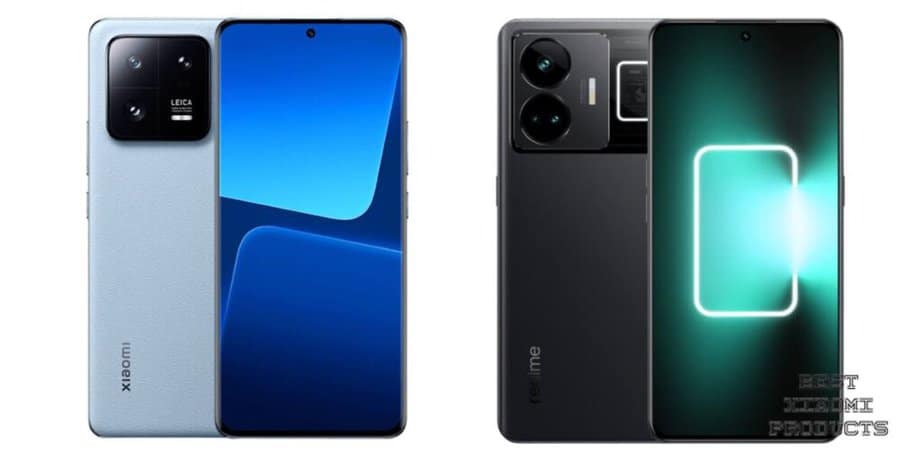
Both phones come packed with features and powerful hardware. After testing both devices thoroughly, here's my detailed comparison of the two devices based on various factors.
| Specifications | Xiaomi 13 Pro | Realme GT Neo 5 |
|---|---|---|
| SoC | Snapdragon 8 Gen 2 | Qualcomm SM8475 Snapdragon 8+ Gen 1 |
| Display | Adaptive 120Hz 3200 x 1440 6.73-inch OLED, 522 ppi, 20:9, 1200 nits (1900 peak) | AMOLED 1B colors, 144Hz, HDR10+, 1400 nits brightness, 20:9 ratio, ~451 PPI density |
| RAM | 12GB | 8GB, 12GB, 16GB |
| Storage | 256GB | 256GB, 512GB, 1TB |
| Battery | 4,820 mAh | Li-Po 5000 mAh (150W wired) or Li-Po 4600 mAh (240W wired) |
| Ports | USB-C | USB Type-C 2.0 |
| Operating System | Android 13 (MIUI 14) | Android 13, Realme UI 4.0 |
| Front camera | 32MP (f/2.0, 89° FOV) | 16 MP (wide) |
| Rear cameras | 50MP IMX989 primary (23mm, f/1.9), 50MP telephoto (75mm, f/2.0), 50MP ultra-wide (14mm, f/2.2) | 50 MP (wide), PDAF, OIS; 8 MP (112˚ultrawide); 2 MP (microscope) |
| Connectivity | Wi-Fi 7, Bluetooth 5.3, 5G, dual SIM, NFC | Wi-Fi 802.11 a/b/g/n/ac, dual-band, Bluetooth 5.3, A2DP, LE, aptX HD, 5G, dual SIM, NFC |
| Dimensions | 162.9mm x 74.6mm x 8.38mm | 6.45 x 2.98 x 0.35 inches |
| Colors | Ceramic Black, Ceramic White | Purple, Black, White |
| Weight | 229g | 199g |
| Charging | 120W fast charging, 50W wireless, 10W reverse wireless | Li-Po 5000 mAh (150W wired) or Li-Po 4600 mAh (240W wired) |
| IP Rating | IP68 | No |
| Micro SD card support | No | No |
Design
The Xiaomi 13 Pro has an elegant ceramic back that feels sturdy and premium in hand. It's available in two color options, Ceramic Black, and Ceramic White.
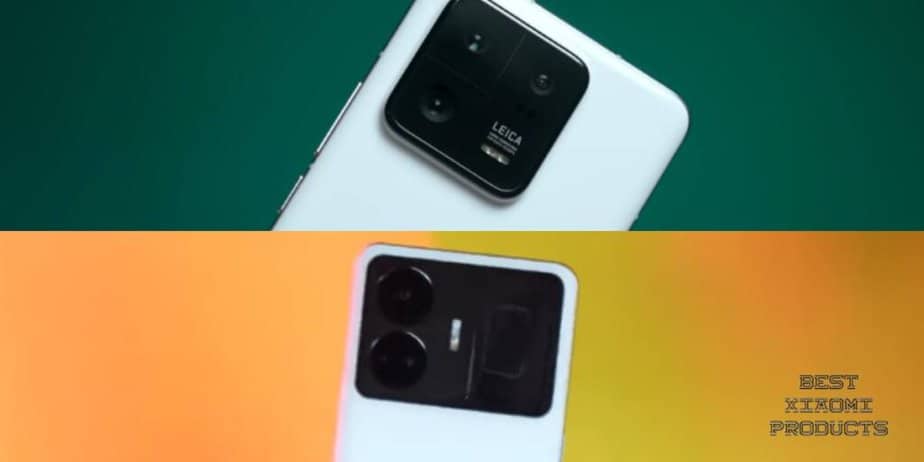
The Realme GT Neo 5 comes with a modern design with an illuminated RGB light on the back. It's available in three colors, Purple, Black, and White. Both devices have a similar weight, but the Realme GT Neo 5 is slightly slimmer, making it more comfortable to hold.
Display
The Xiaomi 13 Pro has a massive 6.73-inch OLED screen with a resolution of 3200 x 1440 pixels. The display is adaptive and can adjust the refresh rate from 60Hz to 120Hz, depending on the task at hand. It's incredibly bright with a peak brightness of 1900 nits, making it easily visible even in bright sunlight.


In comparison, the Realme GT Neo 5 has a 6.74-inch FHD+ AMOLED screen with a 144Hz refresh rate and HDR10+ support. The Realme GT Neo 5 has a slightly higher pixel density of ~451 PPI, making the display crisp and vibrant.
Performance
The Xiaomi 13 Pro is powered by Qualcomm Snapdragon 8 Gen 2 chipset with 12GB of RAM and 256GB of storage. It's a powerful setup that can handle most tasks without any hiccups.

The Realme GT Neo 5, on the other hand, is powered by Qualcomm SM8475 Snapdragon 8+ Gen 1 chipset with up to 16GB of RAM and up to 1TB of storage. It's a slightly faster chipset and offers more storage options than the Xiaomi 13 Pro.
Battery Life
The Xiaomi 13 Pro comes with a 4,820mAh battery and supports 120W fast charging, 50W wireless charging, and 10W reverse wireless charging. The fast charging is incredibly fast, and the device can charge from 0% to 100% in just over 20 minutes.

The GT Neo 5 has a larger 5,000mAh battery but supports only 150W wired charging and 240W wired charging. The wired charging is the fastest available on any smartphone, and the device can charge from 0% to 100% in under 20 minutes.
Camera
The Xiaomi 13 Pro has an incredibly versatile camera setup with three 50MP sensors for primary, telephoto, and ultra-wide shots. The camera setup is one of the best available in the market and can capture stunning photos and videos.

The other one comes with a 50MP primary sensor, an 8MP ultrawide sensor, and a 2MP microscope sensor. While it's not as versatile as the Xiaomi 13 Pro, it's still a great camera setup that can capture stunning photos and videos.
Other Features
The Xiaomi 13 Pro comes with an IP68 rating, making it water and dust resistant. It also has Wi-Fi 7, Bluetooth 5.3, 5G, dual SIM, and NFC connectivity options. Unlike the Realme GT Neo 5, which doesn't have any water or dust resistance rating but is equipped with Wi-Fi 802.11 a/b/g/n/ac, dual-band, Bluetooth 5.3, 5G, dual SIM, and NFC connectivity options.
Xiaomi 13 Pro vs the Realme GT Neo 5 Which is Better?
In conclusion, both the Xiaomi 13 Pro and the Realme GT Neo 5 are excellent smartphones with their own unique features. The Xiaomi 13 Pro excels in terms of camera quality, build quality, and fast charging capabilities, but comes with a high price tag.
The Realme GT Neo 5 offers a powerful processor, a high refresh rate display, and an illuminated RGB light on the back, but lacks some features such as water resistance, an audio jack, and an optical zoom camera.
Ultimately, the choice between the two smartphones will depend on personal preferences and priorities. If you are looking for a premium device with a top-of-the-line camera setup and fast charging capabilities, the Xiaomi 13 Pro is a great option.
However, if you prioritize performance and a high refresh rate display, and don't mind sacrificing some features such as water resistance and an audio jack, the Realme GT Neo 5 is a strong contender.
Xiaomi 12 Pro vs Realme GT2 Pro
These are both the newest and best from each brand. The Xiaomi 12 Pro and the Realme GT2 Pro are excellent devices for the price. From my experience, the Xiaomi 12 Pro has better software with longer support, better cameras, and awesome charging technology. On the other hand, the GT2 Pro has an amazing screen, sleek design, and outstanding performance.
Overall, I prefer the Xiaomi 12 Pro slightly but it is super close between the two devices.
Xiaomi 12 Pro vs Realme GT2 Pro - Specifications
| Model | Xiaomi 12 Pro | Realme GT2 Pro |
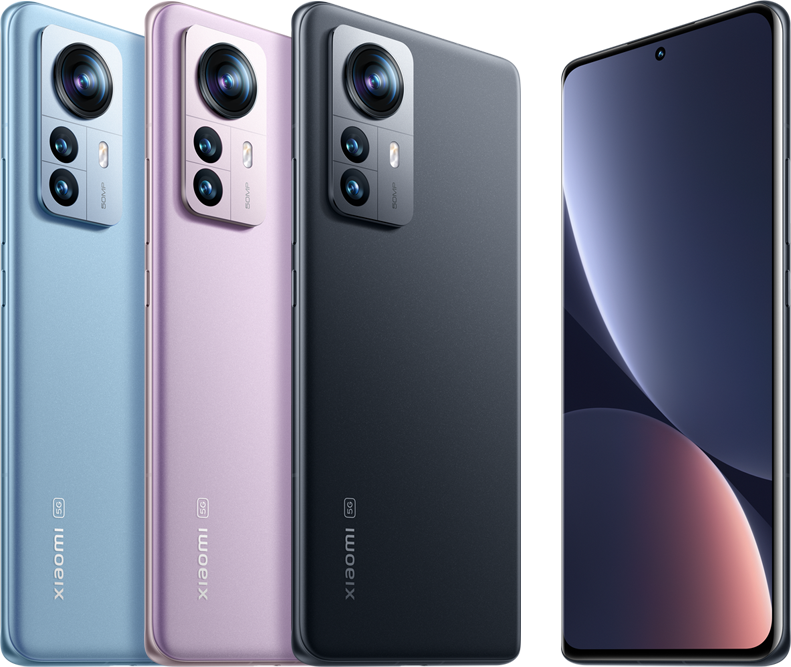 |
 |
|
| Display | 6.73 inches 1440 x 3200 pixels 120 Hz | 6.7 inches 1440 x 3216 pixels 120 Hz |
| Processor | Qualcomm Snapdragon 8 Gen 1 | Qualcomm Snapdragon 8 Gen 1 |
| RAM | 8/12 GB | 8/12 GB |
| Internal storage | 128/256/512 GB | 128/256 GB |
| Camera | 50 MP Wide 50 MP Ultrawide 50 MP Telephoto 32 MP Front Camera |
50 MP Wide 50 MP Ultrawide 40x Magnification Lens 32 MP Front Camera |
| Battery | 4,600 mAh | 5,000 mAh |
| Operating system | MIUI 13 over Android 12 | Realme UI 3.0 over Android 12 |
| Connectivity | Wi-Fi/Bluetooth v5.2/GPS/Infrared/USB Type-C/5G | Wi-Fi/Bluetooth v5.2/GPS/Infrared/USB Type-C/5G |
| Sensors | Fingerprint/Compass/Magnetometer/Virtual Proximity sensor/Accelerometer/Gyroscope | Magnetic Induction/Ambient Light Sensors/Proximity Sensor/Gyroscope/Accelerometer/Ultra-fast in-display fingerprint sensor/NFC |
Xiaomi Mi 10 vs Realme X50 Pro
The Xiaomi Mi 10 and Realme’s X50 Pro were launched earlier this year and both run on Qualcomm’s latest, Snapdragon 865, the same processor in most of the flagships of today. Both devices have a 2.4 GHz Octa-Core processor but there are several limitations with the Realme X50 Pro. For example,
Display
The X50 Pro has a smaller Super AMOLED display that measures in at 6.44” as compared to the Mi 10’s larger screen of 6.67” dot display. Xiaomi’s Mi10 Pro has a display density of 386 pixels per inch whereas the X50 Pro can deliver a clearer picture with its 402 PPI display. The clarity of the display is not always about the size of the screen.
Storage
In terms of memory and storage, Xiaomi’s Mi 10 and the X50 Pro have 8GB each. The storage capacity on these smartphones is the same at 128GB on the Mi 10 Pro and 128GB on the X50 Pro.
Camera Setup
The Xiaomi Mi 10 has a 108MP Quad camera array, the X50 Pro comes with a low resolution 64MP Quad camera setup, but would end up outshining the Mi 10 with their 32MP + 8MP dual Selfie camera.
Specifications
| Realme X50 Pro 5G | Xiaomi Mi 10 | |
 |
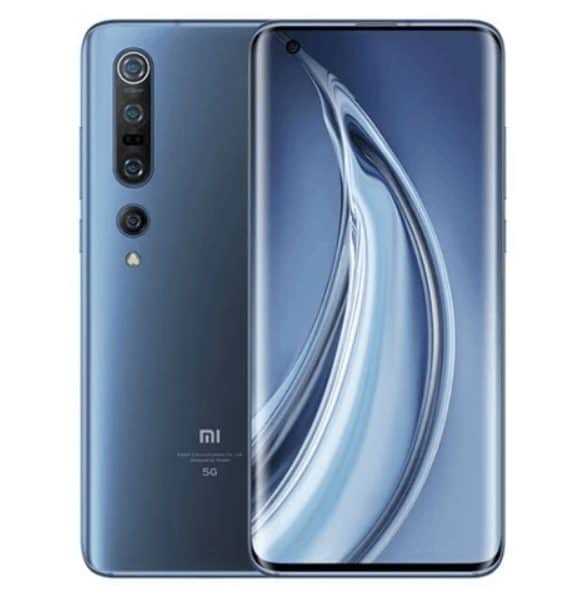 |
|
| Display Type | Super AMOLED (16.7M) | Super AMOLED (16M) |
| Display Size | 6.44” 1080 x 2400 pixels, 90 Hz | 6.67” 1080 x 2340 pixels 90Hz |
| Memory | 8GB | 8GB |
| Storage | 128GB | 128GB |
| Rear Camera | 64 MP f/1.8 (Main)12 MP f/2.5 (Telephoto)8 MP f/2.3 (Ultra Wide)2 MP f/2.4 (Mono) with autofocus | 108 MP f/1.7 (Wide Angle)8 MP f/2 (Telephoto)12 MP f/2 (Portrait)20 MP f/2.2 (Ultra Wide) with autofocus |
| Front Camera | 32 MP f/2 (Wide Angle)8 MP f/2.2 (Ultra Wide) | 20 MP f/2 (Wide Angle) |
| Processor | Qualcomm Snapdragon 865; 2.84 GHz, Octa-Core Processor | Qualcomm Snapdragon 865; 2.84 GHz, Octa-Core Processor |
| Battery Capacity | 4200 mAh | 4780 mAh |
| Price | $608.66 | $899 |
Verdict: In overall terms of performance, price, and design, the Mi 10 emerges victorious.
Xiaomi Redmi Note 9 Pro vs Realme 6 Pro
Coming to mid-range super performers, we have the Xiaomi Redmi Note 9 Pro and the Realme 6 Pro. Both these devices run on a Snapdragon 720G SoC that focuses on power efficiency as well as for gaming.
Display
The Note 9 and the 6 Pro feature the same display size and resolution, the only difference is that the Realme 6 Pro uses Gorilla glass 5 as compared to the Note 9 Pro’s Gorilla glass 3.
Camera Setup
In terms of camera setup, the Realme 6 Pro gets a 64MP Quad-camera setup while the Note 9 Pro comes with a 48MP Quad-camera setup.
Battery Capacity
Powering the Note 9 Pro is a large 5020 mAh battery that in reality does not come close to the backup provided by the relatively smaller 4300 mAh battery on the Realme 6 Pro. With fast charging support, both phones can recharge to full capacity in under an hour.
Specifications
| Realme 6 Pro | Xiaomi Redmi Note 9 Pro | |
 |
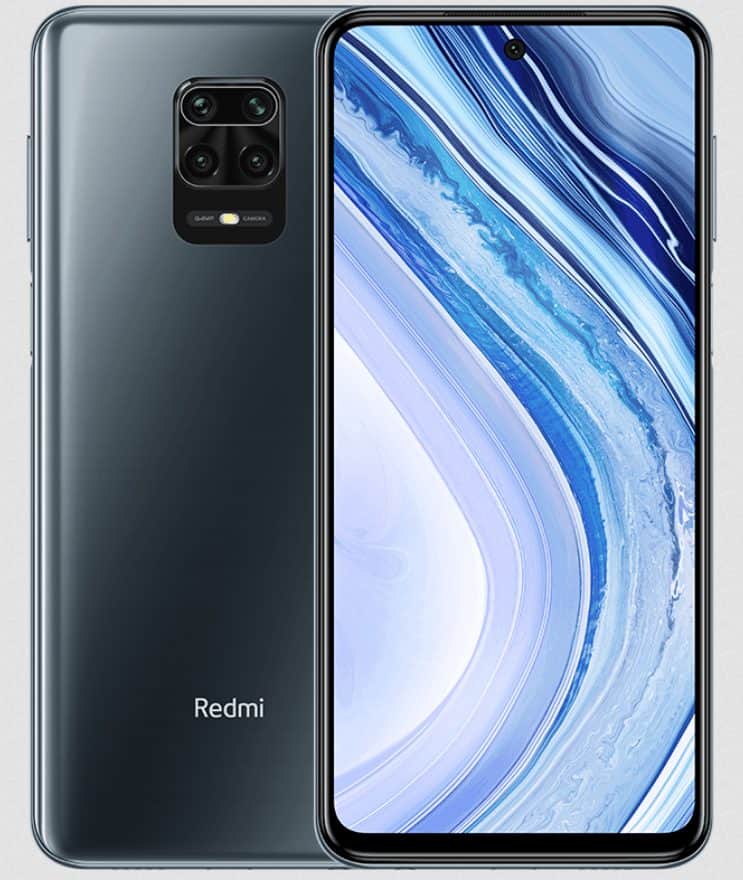 |
|
| Display Type | IPS LCD | IPS LCD |
| Display Size | 6.6” 1080 x 2400 pixels | 6.67” 1080 x 2400 pixels |
| Memory | 8GB | 6GB |
| Storage | 128GB | 64GB |
| Rear Camera | 64 MP f/1.8 (Main)8 MP f/2.5 (Telephoto)5 MP f/2.3 (Ultra Wide)2 MP f/2.4 (Mono) with autofocus | 48 MP f/1.7 (Wide Angle)8 MP f/2 (Telephoto)12 MP f/2 (Portrait)2 MP f/2.2 (Ultra Wide) with autofocus |
| Front Camera | 16 MP f/2 (Wide Angle)8 MP f/2.2 (Ultra Wide) | 16 MP f/2 (Wide Angle) |
| Processor | Qualcomm Snapdragon 720G; 2.3 GHz, Octa-Core Processor | Qualcomm Snapdragon 720G; 2.3 GHz, Octa-Core Processor |
| Battery Capacity | 4300 mAh | 5020 mAh |
| Price | $249.99 | $237.49 |
Verdict: The champion here is the Realme 6 Pro. with a better camera array, battery backup, and overall efficiency.
Xiaomi Redmi Note 8 vs Realme 6
Finally, time for some budget-friendly smartphones, the Xiaomi Redmi Note 7 and the Realme 6. Both these smartphones fall within the same price category but run on different processors.
Display
The Realme 6 has a large display which is 6.5” as compared to the Redmi Note 7’s 6.3” IPS LCD panel. The larger display on the 6 is not as clear though with lesser pixels per inch making it a rather okay smartphone when it comes to overall clarity.
Storage Capacity
The Redmi Note 7 comes with 3GB RAM and 32GB internal memory that can be expanded with the help of a microSD, while the Realme 6 has 4GB RAM with 64GB internal storage which can be expanded with a microSD.
Camera Setup
The Xiaomi Redmi Note 7 is equipped with a 12MP+2MP dual camera setup while the Realme 6 has a 64MP Quad camera. The front-facing camera or the Selfie camera is better on the Realme 6, with a 16MP front camera in comparison to the 13MP front camera on the Note 7.
Specifications
| Realme 6 | Xiaomi Redmi Note 8 | |
 |
 |
|
| Display Type | Colour IPS LCD (16M) | Colour IPS LCD (16M) |
| Display Size | 6.52” 2340 x 1800 pixels 90Hz | 6.3” 2340 x 1080 pixels |
| Memory | 4GB | 4GB |
| Storage | 128GB | 64GB |
| Rear Camera | 64 MP f/1.8 (Main)8 MP f/2.2 (Wide Angle)2 MP f/2.4 (Portrait )2 MP f/2.4 (Macro ) with autofocus | 48 MP f/1.8 (Main)8 MP f/2.2 (Wide Angle)2 MP f/2.4 (Portrait )2 MP f/2.4 (Macro ) with autofocus |
| Front Camera | 16 MP f/2.2 | 13 MP f/2 (Main) with Flash |
| Processor | MediaTek Helio G90T; 2.05 GHz, Octa-Core Processor | Qualcomm Snapdragon 665 MSM8956; AIE Octa-Core Processor |
| Battery Capacity | 4300 mAh | 4000 mAh |
| Price | $198.32 | $299 |
Verdict: Clearly in terms of the overall budget smartphone, the winner is the Realme 6.
Verdict -Xiaomi vs Realme Smartphones
By now you may have already guessed it, on a higher note Xiaomi does wonders with their Mi 10 but as we explored the mid-range and budget segments it was evident that Realme is a better choice to make among these two brands.
This will give Realme the ability to grow exponentially over the next few years and may even take over Xiaomi’s spot in the mid-range best smartphone segment.
However, if you’re looking for a top-notch, high-performance flagship killer Xiaomi is the choice to make, whereas if you’re looking to spend less but have a smartphone with decent specs, Realme will be the right pick.
Xiaomi vs Realme Earbuds
Realme Buds Q vs Xiaomi Airdots

The Apple Airpods and the brand-new Sony WF-1000XM4 may dominate the space for wireless earbuds, but with their $200-and-up price tags, they’re not the most consumer-friendly options out there. Fortunately, there are hundreds of other, more affordable wireless stereo earphones available on the market today, with prices that range from as much as $100 if you’re willing to pay extra for better features and build quality, to as little as $10, if you’re in the market for anything that can get the job done.
In this comparison review, we’re pitting two of the best budget wireless earbuds you can find on the market today to see which one comes out on top: the Realme Buds Q or the Xiaomi Airdots S.
At A Glance - Realme Buds Q vs Xiaomi Airdots
Let’s start this comparison off with a spec-by-spec comparison of the Realme Buds Q and the Xiaomi Airdots S. Check out the table below to see how each one stacks against the other:
|
Category |
Realme Buds Q |
Xiaomi Airdots S |
|---|---|---|
|
Price |
$29 |
$29 |
|
Colors |
Black, Yellow, White |
Black |
|
Build Quality |
IPX4 Water Resistance |
IPX4 Water Resistance |
|
Interface |
USB Type-C |
Micro USB |
|
Bluetooth |
Bluetooth 5.0 |
Bluetooth 5.0 |
|
Sound |
10mm Dynamic |
7.2mm Dynamic |
|
Playback Time |
4.5 hours |
4 hours |
|
Standby Time |
20 hours |
12 hours |
|
Charging Time |
1 hour |
2 hours |
Design - Realme Buds Q vs Xiaomi Airdots

When it comes to design, both the Realme Buds Q and the Xiaomi Airdots S both offer a sleek, minimalist design that’s sure to appeal to most consumers. While the Xiaomi Airdots S is available in all black, the Realme Buds Q is available in black, yellow, and white variants. It’s also worth noting that the Black variant of the Realme Buds Q isn’t completely black; instead, it features premium signature gold accents that add a splash of color to your earbuds. In terms of build quality, both the Realme Buds Q and the Xiaomi Airdots S are well-made earphones, with both sporting an IPX4 waterproof rating, so they’ll be fine from water splashes from any direction.
Sound Quality - Realme Buds Q vs Xiaomi Airdots

Now it’s time to get to the meat of this comparison review: the sound quality. After all, when you’re looking for a pair of TWS earphones, you want to make sure you’re getting good audio for your music, games, videos, calls, and more. Here, the Realme Buds Q takes the lead with their newer and larger 10mm dynamic drivers compared to the Airdots’ 7.2mm dynamic drivers. Having larger drivers gives your audio devices access to a broader range of audio frequencies, so you’re a lot more likely to get better high-tones and low-tones on the Realme Buds Q.
Connectivity - Realme Buds Q vs Xiaomi Airdots
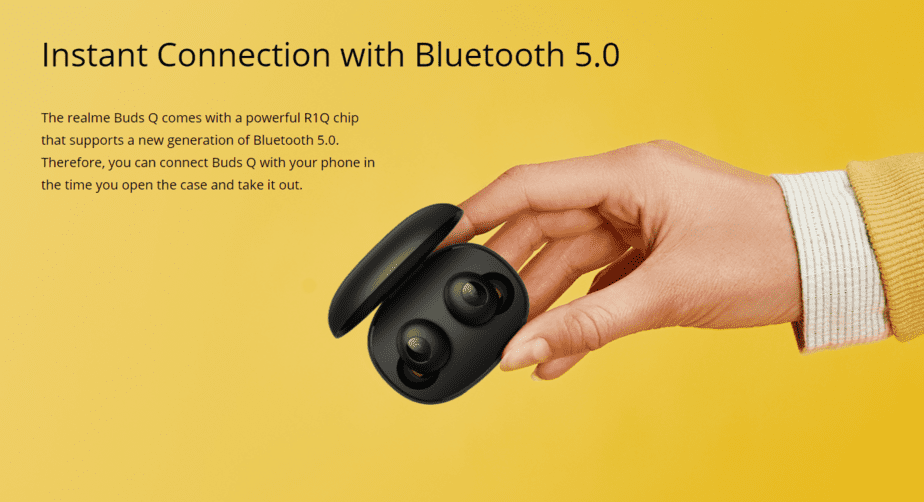
Just like with most true wireless stereo devices in this price range and beyond, the Realme Buds Q and the Xiaomi Airdots S are equipped with Bluetooth 5.0 technology for efficient wireless communication with all of your Bluetooth-enabled devices - your phone, your tablet, your PC, etc. Bluetooth 5.0 is one of the latest iterations of this technology and allows both the Buds Q and the Airdots to be compatible with a very wide range of devices. You’ll be missing out on the new Bluetooth 5.2 features that are available in a lot of newer and more expensive options, but rest assured that Bluetooth 5.0 is more than enough to make either of these wireless earbuds options a great daily driver.
Again, the Realme Buds Q pulls a little ahead here thanks to the USB Type-C port that makes cable compatibility a non-issue. Since most devices today use Type-C, charging your Buds Q case won’t nearly be as much trouble as using the Airdots’ Micro USB connection - that is unless you always have access to Micro USB anyway thanks to your other devices.
Features - Realme Buds Q vs Xiaomi Airdots

When it comes to features, the Xiaomi Airdots S and the Realme Buds Q are neck-and-neck. Both options instantly connect to your paired devices as soon as you take them out of the case. They both also have intuitive controls for user-friendly operation, although the Realme Buds Q does offer the Realme Link app which lets you customize those controls.
Finally, both the Xiaomi Airdots S and the Realme Buds offer a low-latency mode for reduced audio delay when gaming.
Battery Performance - Realme Buds Q vs Xiaomi Airdots

Another important factor to consider when buying a pair of budget wireless earbuds is the battery performance, and in this case, the Realme Buds Q takes the lead yet again. While the Xiaomi Airdots S offers a respectable 12 hours - 4 hours single-use, and another 8 hours with the charging case - the Realme Buds Q blows it away with a combined total of 20 hours of playback - 4.5 hours single-use, and up to 16 hours with the charging case. The Realme Buds Q also offers a longer standby time of up to 50 hours (realistically, only around 20 hours) over the Airdots’ 12 hours, as well as faster charging.
Xiaomi vs Realme TVs
Xiaomi has been successful in the TV business for a few years now with attractive prices and good specs for the money. With TVs getting popular, many other smartphone manufacturers are entering the market looking for a share of the dough.
Realme is one of them too. And their entire range of products is aimed at eating through Xiaomi's potential market share. The best news from this is that the competition between two popular brands has led to better products and pricing for the consumers.
Here is a comparison between two popular TVs from Xiaomi and Realme, Xiaomi TV Q1E and Realme Smart TV SLED 4K.


Design and Display
Xiaomi and Realme both offer premium designs with slim bezels on all sides. The TVs have slim side profiles, so when you wall mount them, they sit flush with the wall.
The Infrared Receiver is off-center on the Realme TV and I found it to be distracting. On Xiaomi, everything is symmetrical making it look better.
The Xiaomi Q1E also features a metal design that makes it look and feel better, I prefer this over Realme’s plastic design.
Both TVs are flagship offerings from their respective brands, so they both feature bright 4K panels with LED (Light Emitting Diode) backlighting. Both TVs are 55 inches in size and max out at 60Hz refresh rates. SO not much difference here.
Xiaomi has opted for a LED-backlit panel with Quantum Dot technology (QLED) which is better than SLED (Superluminescent LED) found on Realme.


QLED allows the Xiaomi Q1E to be brighter, more color-accurate, and display better contrast. I found the picture quality on Xiaomi to be noticeably brighter and better.
When it comes to design and display, the Xiaomi Q1E is better than Realme SLED, but only by a small margin. Though Realme TV falls short when it comes to the display technology used, it offers good picture performance for its cost.
Performance and Software
Both are smart TVs and run on Android TV OS but this section is a clean wipe for Xiaomi. The Xiaomi Q1E runs on Android TV 10 while the Realme SLED features Android TV 9. I found the newer version on Xiaomi is significantly better, with support for more apps, better memory management, and fewer bugs.


When it comes to performance, both TVs run the same 64-bit Quad-Core processor, but the Xiaomi features a better GPU. The Mali G52 in the Q1E is better than the Mali 470 in Realme SLED. Xiaomi also offers more RAM and storage, 2GB and 32GB on the Xiaomi compared to 1.5 GB and 16GB on Realme.
The Xiaomi Q1E offered a better user experience thanks to newer software and faster performance. I found myself enjoying the content more than getting frustrated at occasional glitches and stutters from the Realme SLED. You can also store more content locally on the Xiaomi TV.
If you consume a lot of content and keep apps running in the background, go for the Xiaomi Q1E. If you also run graphical applications and want to do some light gaming, then steer clear of the Realme TV.
Speakers, Ports, and Other Features
When buying TVs at these prices, I would avoid using the inbuilt speaker and get a soundbar or a full set of speakers but if you can only use the inbuilt speakers, then here's how they compare.
The Xiaomi Q1E houses 6 speakers with a maximum sound output of 30W and I found these to be much louder and clearer at louder volumes compared to Realme’s set of 4 speakers at 24W.
Both TVs are even when it comes to ports with both featuring 3 HDMI, 2 USB, 1 headphone jack, and a component port.
Other features like Dolby Audio and connectivity are identical on both TVs, so there's nothing setting them apart here. You should also know that the Realme TV consumes less power than the Xiaomi so if you are power conscious, go for the Realme TV.
Overall
The Xiaomi TV Q1E is better than the Realme SLED TV in almost all important metrics. It has better picture quality, better speakers, newer software, and faster performance. It doesn't lag behind the Realme SLED TV in anything except power consumption.
So I would choose the Xiaomi Q1E over the Realme SLED 8 times out of 10. The 2 times I would pick Realme is when I am strictly constrained by budget since it costs significantly lower. So, Xiaomi takes the win when it comes to TVs.
Xiaomi vs Realme - Other products like Power Banks, Speakers, and Laptops
Xiaomi is one of the older Chinese brands when it comes to smartphones, they have been in business for over a decade now. This has allowed them to develop products like power banks, speakers, and even laptops. And these products have only gotten better with time.
Just like Xiaomi, Realme and other smaller brands are catching up fast with Xiaomi, offering similar products at similar prices or sometimes even lower. I have grown a liking for Realme power banks, speakers, and laptops, they are feature-rich and don't cost much.
When it comes to power banks, I would choose Xiaomi over Realme as they come in high capacities of up to 30,000 mAh. Xiaomi power banks are also proven to be reliable and safe with many safety features.
For speakers, the competitor is pretty even between the two brands. Xiaomi has more options, so you will find better speakers for specific use cases. Speakers from both brands sound good and look premium, but the options from Xiaomi give them a slight edge.


I prefer the Realme soundbar over Xiaomi’s thanks to the included subwoofer. It sounds much better and has a wider soundstage. Get it if you are looking for an affordable sound system for your home theatre.
And for laptops, Xiaomi has a few models on offer, while Realme recently launched their first laptop. Xiaomi's laptops cover price categories from budget to midrange, while Realme offers only one midrange laptop.
When similarly priced models are compared, I feel that Realme offers the better value thanks to its excellent screen, good keyboard, and large trackpad. Xiaomi offers similar specs, but Realme has a slight edge in the midrange market. I would choose Xiaomi Redmibook (lower-end model) if you are strapped for cash.
Overall, among the two, I would offer Xiaomi a little edge over other products, thanks to its more varied product catalog. But every day Realme is trying to close this gap and even surpass it if possible. As usual exciting competition leads to exciting innovation.
Xiaomi accusing Realme
While the battle between Xiaomi and Realme has always been regarding their products, the competition has gotten out of hand when Xiaomi accused Realme of being copycats. There are also times when CEOs from both bands have had altercations on Twitter.
This accusation was in response to the Realme Fan Festival from August 2021, which was identical to the Mi Fan Festival that Xiaomi organized earlier that year. Both these events were organized for the Indian market where the competition between the two companies is hot.
Xiaomi - Pros and Cons
Pros
- Xiaomi phones have some of the best custom ROMs for customizing
- The Mi community and also the Mi forum are great places to ask your queries and get them resolved
- Xiaomi has many different products that vary from water purifiers to table lamps and vacuums.
- Their app store has some gems.
- Xiaomi has a better ecosystem with tablets, laptops, smartwatches, and other cool smart devices.
- MIUI is a better UI than Realme UI
- Better update policy especially for recent phones
- Good performance for the money even for 3+ years.
- Good Customer Service.
- Monthly security patches for 2+ years.
- You get Mi coins for all the purchases made on their website
- They provide Mi Protect, insurance against phone damage.
- They have their own Xiaomi app called Mi Home that works with all their smart products.
Cons
- Customers have complained about the return and replacement policies of products purchased from their website.
- Mi Protect insurance takes a lot of time and requires you to pay a bit as well.
- Xiaomi runs out of stock easily, especially during sales and new launches.
- Devices come with a lot of pre-installed bloatware and less useful Google apps.
- They run a lot of ads on their devices, especially in the budget segment.
Realme - Pros and Cons
Pros
- Realme offers good devices at affordable prices.
- RealmeUI offers some cool features like Dual Audio mode.
- The display quality of Realme devices is generally better than Xiaomi. (Not true for all devices though)
- Realme has ‘Call Me’ which is a pickup and repair service.
- Realme devices have good cameras.
- They have Realme community and forums but not as good.
- They also have Realme website that is similar to Xiaomi’s website.
- Unlike Xiaomi, they have a larger stock during sales and launches.
- Realme Store app allows you to purchase products.
- Excellent Customer Support & Service.
- Less pre-installed bloatware compared to Xiaomi Devices.
Cons
- Poor software updates, with most phones receiving updates for 1 year only.
- They were critical of Xiaomi placing Ads on MIUI while they do the same and call them "Recommendations".
- They have little to no custom ROM options, tweaks, or mods support.
- Their devices tend to ship with MediaTek processors which are generally weaker than the Snapdragon ones.
- RealmeUI is not as optimized or fleshed out as MIUI.
- Releases a lot of devices with minor differences.
- Updates can occasionally issues to User Experience.
Xiaomi vs Realme - Verdict
All in all, both the Realme Buds Q and the Xiaomi Airdots S are excellent budget wireless earphones. The Xiaomi Airdots S, although $10 cheaper, offers good performance and connectivity that should cater to the needs of most users just fine. However, the slightly more expensive Realme Buds Q has the advantage with their larger 10mm dynamic drivers for higher quality audio and a broader sound stage.
Despite using the same Bluetooth 5.0 technology for wireless playback, the Realme Buds Q also pulls ahead in terms of connectivity thanks to the implementation of the universal USB Type-C connection instead of the older Micro USB used on the Airdots S.
If you want to pay as little as possible for a pair of wireless earbuds that offer good sound quality, standard playback time, and reliable performance, the Xiaomi Airdots S is cheap and highly effective. On the other hand, if you’re willing to pay a little extra to get a little extra - better sound, longer battery life - then the Realme Buds Q is the TWS option for you.
Xiaomi vs Realme - FAQs
Are Redmi and Realme the same?
Why are Realme phones so cheap?
Which brand is better, Xiaomi or Realme?
Also Read: